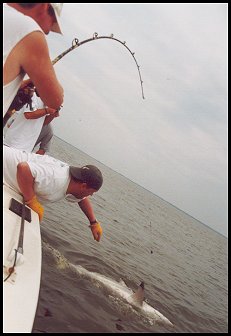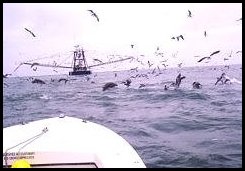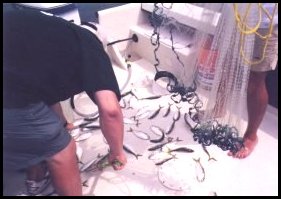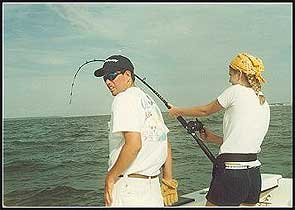Extreme Sharking
Extreme Sharking
By Richie Lott
Shark Fishing is NOT a sport of the past when using proper tactics and light tackle. In the Modern day of fast center console boats and King Fish Tournaments we are caught up in, one of the best sports that have gone past us on the wayside is Shark Fishing.  We have all been there. In the middle of the Greater Jacksonville King Mackerel Tournament, the flat line gets crushed or the DownRigger clip pops and the excitement on board soars in hopes of a Smoker King on the line. Then, the roof caves in. "Man, it’s just a *&@** Shark!" This is disappointment at it’s best during times of competition. Aside from the Tournament agony these fish cause, you may want to consider what a ride that fish gave you while you had him on. We have all been there. In the middle of the Greater Jacksonville King Mackerel Tournament, the flat line gets crushed or the DownRigger clip pops and the excitement on board soars in hopes of a Smoker King on the line. Then, the roof caves in. "Man, it’s just a *&@** Shark!" This is disappointment at it’s best during times of competition. Aside from the Tournament agony these fish cause, you may want to consider what a ride that fish gave you while you had him on. As much as some anglers hate to deal with the toothy critters, catch and release Shark Fishing has become a big time sport among recreational fishermen, and when I say fishermen, I am speaking of men, women and children. "Where are all the Big Ones?" The days of killing 14 ft. Tiger Sharks, Bulls and Hammerheads are over for several reasons. Some anglers consider this kind of killing to be inhumane just to have a Jaw full of teeth on the wall. The biggest reason we don’t see a lot of big Sharks being caught today, is many of the larger fish are gone! They are far and few in between and each year their numbers decline due to Shark Netters and Long Liners in certain areas. Shark Fins are a hot commodity in Asia. These people pay top dollar for these fins, and due to supply and demand, we really need to take extra care of this fishery before Sharks become a fish of the past. "On the Bright side" The good news is, the smaller Inshore species (20 – 150 Pounds) are still plentiful in most Coastal areas. Black Tips, Spinners, Lemons, Browns and Black Nose Sharks engulf areas that hole up baitfish or have trawlers working in the area. As a Charter Boat Guide and IGFA World Record Holder for a Black Tip Shark, I can tell you these fish pull like no other in the Coastal Waters. I would rate the battle right up there with a Tarpon in fight comparison. Last year, I saw so many Sharks swimming around my boat on several trips; it honestly made me a bit nervous. With younger anglers on the rod and the drag set at an uncomfortable 13 pounds, I had visions of the angler falling over board into the infestation in our chum slick. It’ll get your blood pumping when you see all those 100-pound toothies prowling around your boat. "Got Shrimp Boats?" There is no easier way to catch these Coastal Sharks than behind a Shrimp Boat. These fish gather around the bags of the nets in hopes of chomping on anything that falls out while the trawling is underway.  When the nets are raised, the Captain normally slows the boat to an idle speed while the bags are dumped onto the deck for culling. All the small fish and worthless By-Catch is literally "Snow Shoveled" out of the giant scupper holes on the deck. When the nets are raised, the Captain normally slows the boat to an idle speed while the bags are dumped onto the deck for culling. All the small fish and worthless By-Catch is literally "Snow Shoveled" out of the giant scupper holes on the deck. This is the dinner bell for many species of fish as they have followed for an hour or more waiting for this moment. The myth about Dolphins running off Sharks is proven at this time. Those Sharks get right up there and feed with the Dolphins as they work themselves into a frenzy. Now and then you will see the Black Tip Sharks get up in the air and do a barrel roll right off the bow. That’s always special when you’re standing on the bow looking around for a large fish to target and a 130 pounder decides to breathe some fresh air. I promise you, if it’s close enough, you won’t ever forget it! "Fishing In the Mud" When the Shrimp Boats trawl, their nets are directly on the bottom. This leaves a tell tale brown slick behind the boat for a mile or so. You’ll notice Dolphins running in and out of the slick and Jack Crevalle will sometimes be feeding on the surface, too. The one thing you can’t miss, is that giant fin roaming through the mud slick in confusion as he hunts down the food source. This is the time to put out the lines. Normally, there is no need to get too comfortable, especially if you have spotted fish on the surface. In fact, if you are positioned correctly in the slick, you won’t have time to put the reel in gear, so watch your tumbs! "Baiting Up"  All you need is 20 or so "Thumper Menhaden" to get this job done. They make up a huge part of the Coastal Shark diet along with other small scale fish such as Whiting, Sand Trout, Star Drum and Tounge Fish. All you need is 20 or so "Thumper Menhaden" to get this job done. They make up a huge part of the Coastal Shark diet along with other small scale fish such as Whiting, Sand Trout, Star Drum and Tounge Fish. If you happen upon a school of 6-10 inch mullet, net a few just to change things up a bit, and these fish will take a whiting on the live line, too. If you are a big fan of using lures as I am, try a Yozuri "Hydro Tiger". They can’t stand to look at that thing. I don’t know what they think it is, but they just have to kill it. Just work it hard across the slicks where you have located fish. Don’t use your most expensive lure in the box, either. They will scratch one very much bad, usually beyond reuse. "Mono Leader? Why not?" I have caught far more than my share of these fish over the last 20 years. I have never used wire leader in my life. These smaller targets are not quite as brutal as their bigger brothers are. Sure, you’ll lose a few fish with this technique, but the sport is what it’s all about anyway with these brutes. 200 Pound mono will land at least 90% of your fish without a break off. Clip yourself off about 6 ft. of 200, tie a loop knot at the top and snap it on the main line. "A Word on Tackle" Go as light as you dare. I generally go with 30-pound main line on a reel that will hold at least 300 yards of it. I am partial to the Shakespeare TW30 Gold Reel. A smooth drag is required when light tackle angling for these fish.  As far as rods go, you need a meat stick with a bit of backbone. The BEST rod you can possibly use for this brutal, extreme sport is an Ugly Stik (BWB 1120). When you’re pitching to heavy hitters, you need a big bat to hit with and Ugly Stik is the one. As far as rods go, you need a meat stick with a bit of backbone. The BEST rod you can possibly use for this brutal, extreme sport is an Ugly Stik (BWB 1120). When you’re pitching to heavy hitters, you need a big bat to hit with and Ugly Stik is the one. Tie on a 100-pound snap swivel to the main line, and then on the end of your 6-ft. 200-pound leader, add a 7/0 long shank straight hook. The long shank will most times prevent the Shark from biting on the leader. If the fish is biting on the shank of that hook, he can’t bite the leader. You won’t need any weight on your line or leader to do this job. Fish your reels in gear to ensure a solid hook up, and with any luck at all, this will have helped you sink the hook right into the Jaw, preventing a gut hooked fish. Pull out your digital scale and hook it onto your leader or hook and tighten that drag you are pulling 13 pounds on the scale, or even a bit tighter if your lower back can stand it. This makes it a little rough when you go to grab the rod out of the holder, but the hook set it provides is well worth it. "Identifying Characteristics & Weight for Coastal Species" - Black Tip Shark – 15 to 125 Pounds
- Spinner Shark – 30 to 150 Pounds
- Black Nose Shark – 15 to 45 pounds
- Lemon Shark – 30 to 140 Pounds
- Sharp Nose Shark – 8 to 20 Pounds
The Difference between a Black Tip and Spinner Shark is the most difficult to identify. The main distinguishing difference is a more streamline "Missle Shaped" body of the spinner and his small, beady eyes. The Black Tip will not be quite so streamline with the dorsal fin slightly rearward of the pectoral fins as you look at the fish from above, where the Spinner has an offset dorsal that lines up more in line the Pectoral fins. Also, the anal fins if the Black Tip Shark DO NOT have black edges. The Spinner Shark will have Black edges on the anal fins. Spinners and Black Tips are both jumping Sharks. Most times, and angler thinks they have a Spinner on the line because of the jumping and acrobatic maneuvers they are encountering. You won’t know which species that fish is until you have the fish boatside. The most common misconception of Cosatal Shark Species is the Black Nose Shark, which is confused with a Sand Shark or Brown Shark as they are often referred to. In all actuality, I have seen very few actual Sand Sharks over the past few years. The Black Nose Shark has a very obvious black dot directly on the front of the head, and the skin color is Brownish/Green in color. Black Nose Sharks are often confused with Lemon Sharks, too. The best way to identify a Lemon is the (2) dorsal fins on his back. It is one of the few species with that characteristic. A nurse shark has a double dorsal, but has a dark brown, hard skin with a mouth similar to a giant catfish. They even have small whiskers around the mouth area. One other common mix up between species is the Sharp Nose Shark. Once again, many anglers think this is a Sand Shark. Look closely, and you’ll find the Sharp Nose has white spots all over his body. Also, this fish usually will not exceed 48" in length. The Sharp Nose is a small Coastal Shark, and their fight for freedom is not nearly as intense as others mentioned here. Boat Positioning Boat position is extremely important when you fish behind a Shrimp Boat or other Trawling Vessel. Unless the boat is dumping by catch, you’ll want to set up in the mud slick behind the boat. The proper set up is normally around fifty yards behind a moving trawler directly in the slick. Remember to judge your current and wind direction to obtain the longest drift possible while keeping your position in the slick. This is where the fish will be. When the strikers on the boats are dumping their by catch, get right up behind the boat and put the lines out in a position that will drift you behind that trawler as long as possible. If you are new to fishing for large fish with light tackle, get ready for some of the most extreme and intense fishing available to you on your coastline. Get your children involved in this sport and teach them the values of catch and release Sharking. Use caution Handling Large Sharks Even the most experienced Shark handlers get bit. The most aggressive species is the Black Tip and Spinner Shark. The best way to handle these speedsters would be pulling the fish close, get a picture, and cut the Leader. They WILL bite as they are in a state of confusion and extremely tired. When you wire a large Shark, please, use gloves when you grab that leader. My fingers and hands are terribly scarred from bare handing the leader when the fish took off for a another shot at freedom. To sum it up, you simply don’t bring that fish in the boat, and gaffing the fish will infuriate it. That fish may take you overboard if you attempt a lip or jaw gaff.
|
